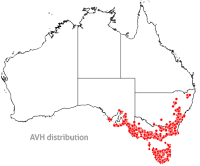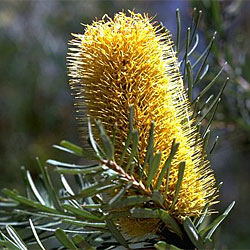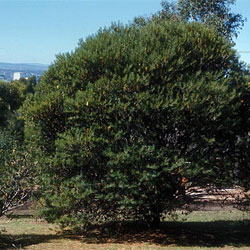Banksia marginata
Silver Banksia, Honeysuckle
 Banksia marginata, otherwise known as Silver Banksia and Honeysuckle, belongs to the Proteaceae family. Its natural occurrence is throughout south-eastern Australia; from Eyre Peninsula, South Australia, through Victoria and eastern New South Wales north to Baradine and Guyra, and throughout Tasmania.
Banksia marginata, otherwise known as Silver Banksia and Honeysuckle, belongs to the Proteaceae family. Its natural occurrence is throughout south-eastern Australia; from Eyre Peninsula, South Australia, through Victoria and eastern New South Wales north to Baradine and Guyra, and throughout Tasmania.
It is the most variable species of the banksias in relation to habit and habitat, and can occur as a shrub or tree 1 – 12 metres tall. Typically it is a medium sized shrub about 2 metres high by a similar spread. Some forms have a lignotuber, which is a woody swelling at the stem base that regenerates after fire.
Leaves are up to 60mm long and 3 to 13mm wide. Upper surface is dark green with the lower surface white and hairy, appearing silvery in the wind. Small serrations may be found on the leaf edges and tips. The pale yellow flowers are arranged in pairs and densely packed in cylindrical spikes which are up to 100mm long. Old spikes may persist on the plant. The seeds are enclosed in follicles attached to a woody cone.
It is a hardy, fairly fast growing and long lived species that can be grown in a wide variety of environmental conditions. It favours a sunny or partly shady position, and may become spindly if grown in the shade. It can tolerate a variety of soil types including sandy soils, loams and clay. It prefers well-drained soils, but can tolerate moist and even waterlogged sites. It is drought resistant and will do well in exposed windy locations.
As the species is quite variable, to have the best chance of success, plants should be chosen from a similar climate to that of the location where it is to be grown. For example, in Sydney, plants should be selected from coastal and mountain regions of NSW. Likewise, if after a frost hardy plant, select a plant originating from a high altitude form, or for salt resistance choose a coastal form.
Flowers can occur throughout the year, but mainly February to July. The seed ripens from February to April, and is indicated by the wood hardening and the follicle colour changing to dark brown.
B. marginata requires low maintenance. They hold their shape very well. Lignotuberous plants can be pruned hard, whereas non-lignotuberous plants should only be lightly pruned. If foliage begins yellowing, apply chelated iron.
It can be propagated from seed or cuttings fairly easily. Use fresh seed for propagation. Sow just beneath the soil from winter to spring, with germination taking place within 4 - 8 weeks. Cuttings can be taken from plants between August and October using firm young growth.
All banksias produce copious nectar and are ideal for attracting wildlife into gardens. The main pollinators are nectar feeding birds, in particular honeyeaters, especially the New Holland Honeyeater. Other pollinators include insects and small mammals such as the Sugar Glider, Feathertail glider, and Eastern Pygmy-possum. Seeds are also eaten by cockatoos, particularly the Yellow-tailed Black Cockatoo.
B. marginata makes an attractive feature plant when flowering. It forms a neat compact shape. Low forms are a useful screen plant or windbreak. Tall forms can be used as street trees. It is also popular as a Bonsai plant.
Text by Jacqueline Britton (2012 Student Botanical Intern)
Name Meaning: Banksia marginataBanksia — after Sir Joseph Banks, who in 1770, was the first European to collect specimens of these plants marginata — from the Latin ‘marginatus’ meaning bordered; referring to some forms in which the leaf margins are rolled-under |
References
Canavan, B. (2012) Pers. comm. Horticulturist, Australian National Botanic Gardens.
Collins, K & K., & George, A. (2008) Banksias, Bloomings Books Pty Ltd, Melbourne.
George, A. S. (1996) The Banksia Book, Kangaroo Press, Sydney.
Wrigley, J. W., & Fagg, M. (1989) Banksias, Waratahs & Grevilleas and all other plants in the Australian Proteaceae family, Collins Publishers, Australia.
George, A. S. (n.d.) Banksia marginata. Flora of Australia Online. Available at http://www.anbg.gov.au/abrs/online-resources/flora/ [Accessed February 2012].
Australian National Botanic Gardens (2011) Banksias. Available at www.anbg.gov.au/banksia [Accessed February 2012].
Florabank (2006) Corangamite Region Guidelines - Banksia marginata. Available at http://www.florabank.org.au/files/documents/provenance/20070801-12.pdf [Accessed February 2012].
Stelling, F. (ed.) (1998) South West Slopes Revegetation Guide. Murray Catchment Management Committee, NSW. Available at http://www.murray.cma.nsw.gov.au/swsrguide/home.html [Accessed February 2012].
Department of Primary Industries, Parks, Water and Environment (n.d.) Banksia marginata Notesheet. Available at http://www.dpiw.tas.gov.au/inter.nsf/Attachments/LJEM-7CV6CA/$FILE/Banksia%20marginata%20Notesheet.pdf [Accessed February 2012]
Australian Native Plants Society (Australia) (2007). Banksia marginata. Available at http://anpsa.org.au/b-mar.html [Accessed February 2012].
![An Australian Government Initiative [logo]](/images/austgovt_brown_90px.gif)



